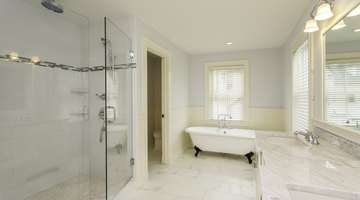Limestone Vs. Marble
Table of Contents
While granite gets all the attention in the kitchen, it's not the only natural stone used in the home. Limestone and marble, which share many properties, each offer benefits to homeowners seeking out alternative finishes for walls, floors and other surfaces.

Though both limestone and marble consist of calcium carbonate, they differ significantly in terms of appearance, composition and application.
Geological Origins
While both limestone and marble are millions of years old, think of limestone as marble's younger cousin. Limestone, a sedimentary rock, forms when shells, sand and fossils solidify over millions of years. When limestone experiences high heat and pressure beneath the earth, it may transform into marble, a metamorphic rock. As the rock is subject to natural heat and pressure, it recrystallizes, growing harder and denser over time. Mineral deposits add color and give marble its distinctive veining and grain.
Appearance and Aesthetics
Despite their similar origins and composition, marble and limestone are easy to distinguish with the naked eye. Limestone typically comes in natural colors such as gray, tan or brown, and features impressions left by fossils and shells. Marble comes in a much wider variety of colors, from white to black, including pinks, tans, grays, reds, blues and greens. All of the fossils within the stone have long recrystallized, and are no longer visible, though the marble may feature veining and streaks of color thanks to the presence of minerals.
Hardness and Density
Marble and limestone lie at the opposite end of the hardness scale from granite. While marble is slightly harder and denser than limestone, both rate very low on the Mohs scale, a rating used to measure the hardness of stones. Limestone generally ranks at around a 3 on the scale, while marble falls between 3 and 4. Soft stones such as talc rank at around a 1 on the scale, while granite falls between 8 and 9 and diamonds rank a 10. Thanks to the heat and pressure that marble is exposed to beneath the earth, it's slightly more compact and less porous than limestone, and marginally less susceptible to staining.
Analyzing Application
Marble and limestone come in the same slabs, panels and tiles used in granite production, but these materials aren't appropriate for the same applications as granite. The National Kitchen and Bath Association warns that limestone shouldn't be used in the kitchen or bath due to the potential for staining and scratches. The NKBA also suggests keeping marble out of the kitchen unless the material is carefully honed and sealed to reduce the risk of stains and damage. Marble serves as an effective finish for bathroom floors and walls, as well as fireplace surrounds and furniture, such as tabletops. Limestone works well when used as a wall panel, on entryway floors or walls and around the fireplace.
Beware of Acid
In addition to their similar roots, marble and limestone share another similarity; both are highly vulnerable to damage when exposed to acidic materials. For homeowners, this means that something as simple as a spilled glass of lemonade or drop of vinegar can leave permanent dull marks on the surface of the stone. This acid etching can only be removed by professionally resurfacing and rehoning the stone.
Comparing Costs
The price of marble and limestone can vary dramatically based on the color, source and treatment of the stone. While limestone generally costs less than other types of stone because it's so widely available and easy to work with, according to Coldspring USA, highly polished limestone or rare colors can easily cost more than certain types of marble.
The Drip Cap
- While granite gets all the attention in the kitchen, it's not the only natural stone used in the home.
- Though both limestone and marble consist of calcium carbonate, they differ significantly in terms of appearance, composition and application.
- Soft stones such as talc rank at around a 1 on the scale, while granite falls between 8 and 9 and diamonds rank a 10.
- The NKBA also suggests keeping marble out of the kitchen unless the material is carefully honed and sealed to reduce the risk of stains and damage.
- Marble serves as an effective finish for bathroom floors and walls, as well as fireplace surrounds and furniture, such as tabletops.
References
Writer Bio
Emily Beach works in the commercial construction industry in Maryland. She received her LEED accreditation from the U.S. Green Building Council in 2008 and is in the process of working towards an Architectural Hardware Consultant certification from the Door and Hardware Institute. She received a bachelor's degree in economics and management from Goucher College in Towson, Maryland.
Photo Credits
- dpproductions/iStock/Getty Images
- dpproductions/iStock/Getty Images
More Articles



